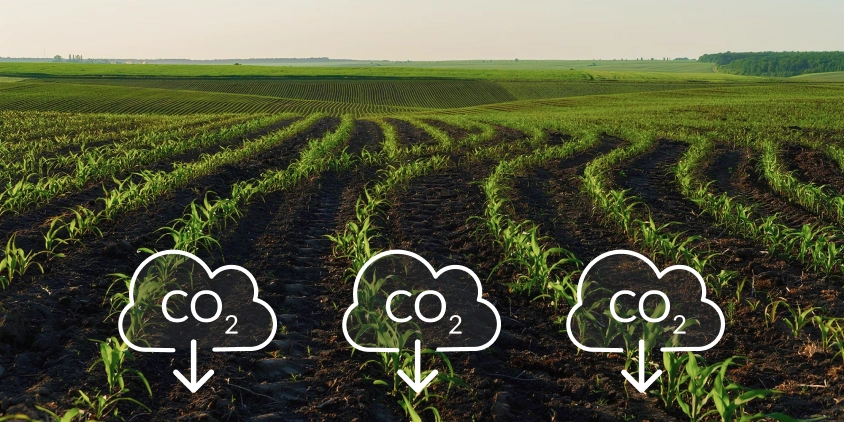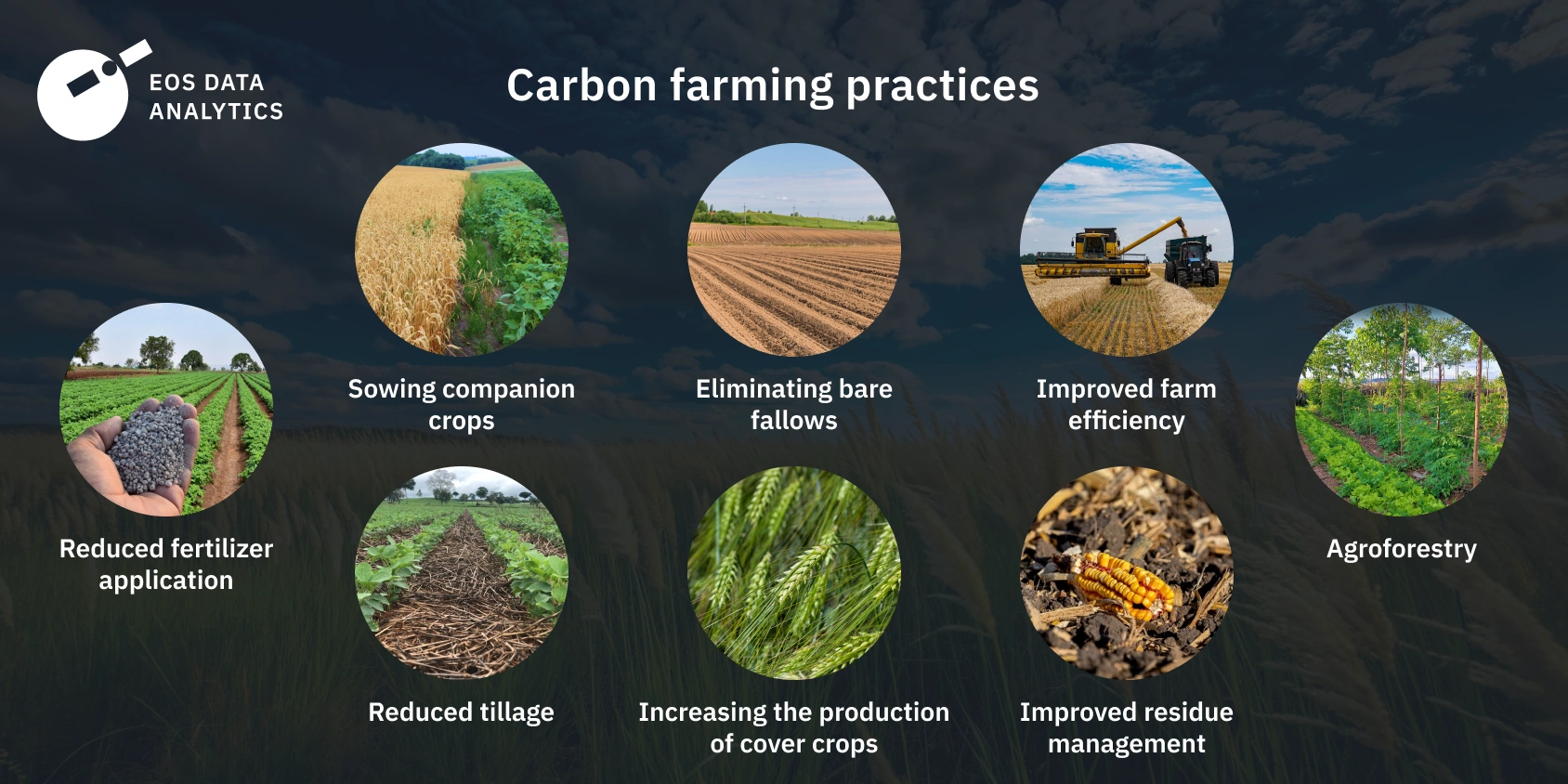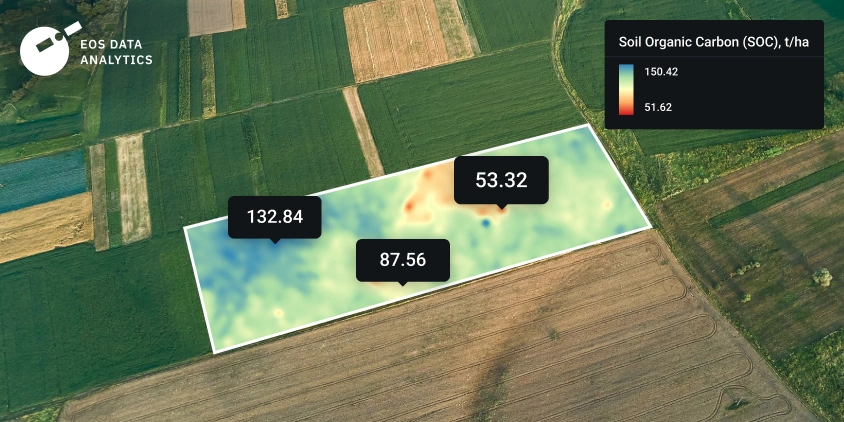
Carbon Farming: What Is It And How To Implement It
Today, agriculture is one of the significant sources of carbon dioxide (CO2) and other greenhouse gas emissions. But things can change with a global transition to carbon farming or even wider adoption of some of its practices. Then, instead of being a source of greenhouse emissions, agriculture can become a sink. This approach has numerous other advantages, including improved soil health, more efficient use of water resources, lower chemical input costs, and carbon credit generation. While still there are challenges to overcome when embracing carbon farming initiatives, which are out of the ordinary for many industrial farmers, contemporary agricultural technology does help a lot.
What Is Carbon Farming And The Idea Behind It?
The basic idea behind carbon farming is to direct the power of agriculture to combat climate change. This approach includes a range of practices mostly aimed at removing carbon dioxide (CO2) from the atmosphere through photosynthesis and storing it in soils, plants, and other organic materials. Many of these practices, such as cover cropping and reduced tillage, are already common to organic and regenerative agriculture.
Farming focused on carbon capture not only helps mitigate climate change but also offers numerous co-benefits, including improved soil health, better water retention, and increased biodiversity. In addition to helping the environment, farmers who engage in carbon agriculture have the opportunity to earn more money by participating in carbon markets. Carbon-conscious farming, which combines agricultural wisdom with climate science, offers a potential answer to the world’s climate problems.
The Most Popular Practices Of Carbon Farming
Carbon-smart farming practices have the goal of actively sequestering carbon and/or reducing farm-related greenhouse gas emissions. These practices, which can be implemented individually or as part of a comprehensive farming plan, also serve as conservation measures. The success of carbon-capture agriculture depends on localized approaches and collaboration with various stakeholders, ensuring that the practices are well suited to particular agricultural settings.
Eliminating Bare Fallows
Bare fallows, once a common agricultural practice, are gradually displaced by carbon farming techniques. Exposed soil readily loses carbon because of winds, rain, heat, etc., counteracting efforts to sequester greenhouse gases. Nitrogen-fixing crops become an alternative: growing plants like clover on otherwise bare lands not only shields the soil from erosion but also enriches it with nutrients. This approach maintains soil health, improves SOC retention, and prepares the land for the next harvest.
Companion Cropping
ompanion cropping is the simultaneous cultivation of crops that support one another’s growth and defense mechanisms. By growing diverse plant species alongside each other, farmers create natural pest barriers and enrich the soil ecosystem. For instance, farmers can plant nitrogen-fixing legumes alongside nutrient-hungry crops to reduce the need for fertilizer. This crop symbiosis also enhances overall soil health.
Agroforestry
Agroforestry refers to farming practices that intentionally incorporate trees with crops, providing an environment similar to how various biological systems collaborate in nature. Agroforestry operates both below and above ground: the roots move nutrients and store carbon deeply underground, while the trees shield crops and animals from adverse weather and other aboveground impacts . In this carbon farming method, crops, trees, and the ecosystem all work together, which allows to:
- increase farm productivity;
- protect soil from erosion;
- purify air and water;
- provide habitat for wildlife;
- diversify farmers’s revenue streams.
Cover Cropping
Unlike traditional cash crops, cover crops are cultivated primarily to protect and enrich the soil. These plants help minimize surface disturbance, capture nutrients, and build up soil organic carbon (SOC). By cover cropping, farmers can enhance soil fertility while simultaneously contributing to CO2 removal from the atmosphere.
Reduced Tillage
Reduced-tillage carbon farming involves minimal soil disturbance, often using no-till drills or strip-till equipment to plant crops. By leaving crop residues on the field and limiting soil turnover, reduced tillage helps retain SOC. Minimum or no-tillage practices also protect against erosion, improve water infiltration, and support beneficial soil organisms. While the shift may present initial challenges in pest and nutrient management, many growers find that reduced tillage leads to more resilient, productive farmland over time.
Crop Residue Management
Crop residue management, in a nutshell, is when growers keep plant remains in fields post-harvest to create a protective blanket for their soil. As microorganisms break down the residue, they improve soil structure and sequester carbon. This carbon-smart farming practice not only reduces erosion but also minimizes the need for synthetic inputs, creating a more sustainable and productive agricultural system.
Reduced Application Of Synthetic Fertilizers
Nitrogen fertilizers are vital to food security, but they also contribute about 5% of the world’s greenhouse gas emissions. To cut back on emissions from synthetic fertilizers, the best way is to use fewer of them . We all need to combine economic, technological, and policy measures that encourage organic fertilization to really make this strategy work without sacrificing soil fertility.
Improvement Of Farm Operation Efficiency
Boosting farm efficiency is a key carbon-smart farming strategy. Farm management software helps keep operations smooth, track duties, and plan resource use. Proper irrigation management prevents nutrient loss and erosion. Variable rate technology optimizes agricultural input and fuel consumption. All of these practices both cut costs and reduce emissions. By focusing on efficiency, farmers can increase productivity while minimizing their environmental footprint.

Benefits And Challenges Of Carbon Farming
Carbon farming provides many benefits to farmers, ranging from increased soil fertility to the ability to generate carbon credits (CCs). However, implementing any new approach — and carbon agriculture is no exception — has its own challenges. Let’s explore both sides of this approach.
What Are The Benefits Of Carbon Farming?
Carbon-smart farming offers numerous advantages for both the environment and farmers’ bottom lines. Here are the key benefits:
- Improved soil health. Carbon-rich soils have improved structure and fertility, promoting high yields and reducing erosion risks.
- Water efficiency. Better soil structure increases water retention, which means improved irrigation efficiency and potential cost savings.
- Use of crop residue. Carbon farming practices, which encourage more efficient and sustainable use of crop residue, basically turn trash into treasure, lessening the need for chemical inputs and minimizing ecological hazards.
- Biodiversity support. Carbon-sequestration farming practices promote beneficial microorganisms and insects (for example, cover and companion cropping) and create wildlife habitats (agroforestry).
- New revenue streams. Farmers can generate extra income by selling carbon credits to organizations looking to offset their emissions.
- Reduced input costs. Improved soil health and water retention can decrease the need for fertilizers and irrigation, leading to significant cost savings over time.
- Sustainable land management. Carbon-smart farming practices contribute to long-term land health, preserving farm value and productivity for future generations.
These and other benefits make carbon-sequestration farming an attractive option for many businesses. But it’s crucial to approach this with a balanced perspective. Let’s now look at some challenges that farmers might face when implementing carbon farming initiatives.
Are There Any Disadvantages Of Carbon Farming?
As we’ve already seen, carbon-sequestration agriculture is good for farmers’ budgets and the environment because it provides a sustainable and all-encompassing way to control land use. However, landholders’ emphasis on the short term and the impossibility of endlessly sequestering carbon in the soil slow down its widespread adoption. The potential challenges of carbon-smart farming are:
- Upfront investments. Transitioning to carbon-smart farming practices often requires upfront investments in equipment and training. However, these costs may be viewed as investments in farm resilience and long-term profitability, with many practices leading to reduced input costs and potential additional income through CCs.
- Slowing sequestration rates. While carbon capture through farming is rapid in the first years, particularly in degraded soils, the rate is likely to slow as soil health improves. Taking this into consideration, the benefits of carbon sequestration for farming may be more apparent in the near to medium term.
- Land availability. Some carbon-smart techniques, like agroforestry and cover crop production, require allocating arable land. Naturally, this can diminish crop output in the short run, posing a challenge for small farmers. However, in the longer run, implementing carbon farming practices that safeguard the soil and crops results in the same or even higher yields than before.
Numerous environmental and economic advantages of carbon farming outweigh any potential disadvantages. By using smart strategies and technologies, particularly EOSDA’s innovative SOC modeling, farmers and project developers can maximize the benefits of carbon-smart farming.
How EOSDA’s Solutions Help In Carbon Farming
Success in carbon-smart farming demands precise, up-to-date information. Without it, farmers risk leaving potential benefits on the table. Fortunately, EOSDA has developed a suite of powerful satellite monitoring and SOC modeling tools to give carbon-conscious farmers the edge they need.
At the heart of EOSDA’s offerings is the novel soil organic carbon modeling solution, which enables you to establish a baseline of your fields’ current SOC levels and monitor changes over time as a result of the adoption of carbon-sequestration farming. This empowers you to:
- build a solid foundation for future carbon credit claims;
- reduce soil sampling expenses by up to 90%;
- generate highly precise soil maps;
- make data-driven decisions for optimal resource allocation.

EOSDA’s model boasts integration with high-resolution data and excellent scalability, making it ideal for large-scale projects. Plus, our dedicated R&D team can fine-tune the model to your specific needs, considering unique field characteristics and local climate patterns.
But that’s not all. EOSDA offers a suite of complementary solutions for carbon-conscious farmers, including tillage and cover crop detection, VRA (variable rate application) maps, and field boundary detection. Ready to optimize your carbon farming efforts? Contact us via sales@eosda.com for more information.
By embracing EOSDA’s solutions, you’re not just increasing your farm’s productivity — you’re actively contributing to global climate change mitigation. As carbon-smart farming gains traction, agri players with the necessary skills and knowledge will lead the way to a more sustainable agricultural future.
About the author:
Lidiia Lelechenko holds a Master Degree in Viticulture, Winemaking & Marketing obtained in ESA (École supérieure d'agricultures d'Angers). She has over 6 years of experience in various roles related to SaaS solutions sales and research activities in sensory analysis. Currently, Lidiia is responsible for strengthening EOSDA presence and recognition on European markets as an Account Executive.
Recent articles

Analyze 2025 & Plan Your Best Year Yet: LandViewer Christmas Offer
It’s the most wonderful time of the year! The Christmas holidays are here, and so is your chance to analyze 2025 and plan a prosperous 2026 with more affordable Pro plans in LandViewer.

EOSDA Models Climate Change Impact On Sugarcane Yields
EOSDA modeled future temperature, rainfall, and other climate impacts on Veracruz sugarcane. The results help growers plan long-term adaptation strategies, including timing, varieties, and irrigation.

EOSDA LandViewer Black Friday Sale: Exclusive Offers & Giveaway
This Black Friday, LandViewer offers new users the chance to save on monthly plans, get extra months with yearly subscriptions, and participate in a free annual plan giveaway.